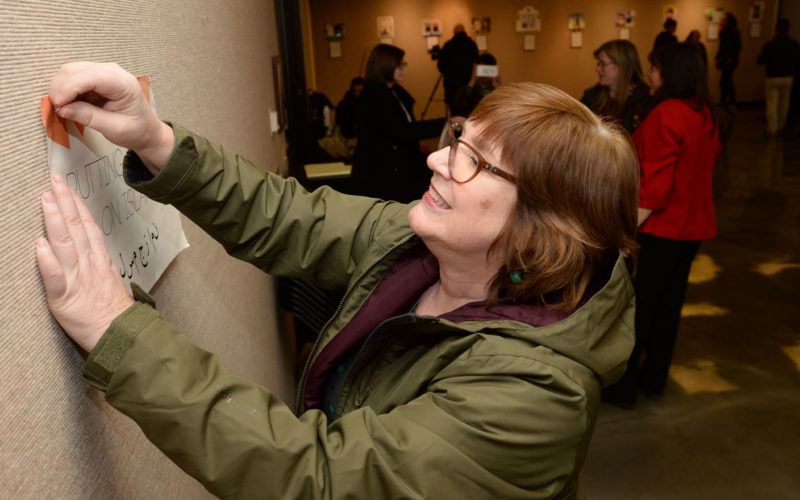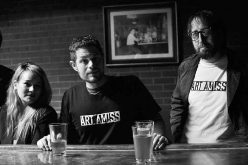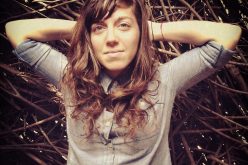Art project provides insight at Fayetteville High
DAVE PEROZEK
dperozek@nwadg.com

The Free Weekly/ANDY SHUPE
Lilly Stults, 16, (left) a junior at Fayetteville High School, shows Mahfuza Akhtar, administrative support supervisor for the Fulbright School of Arts and Sciences at the University of Arkansas, the art she created inspired by Akhtar on Jan. 30 during the opening of a show featuring art dealing with interactions with Muslim and Islamic community members created by 18 Fayetteville students in the Anne Kittrell Art Gallery at the Arkansas Union on the university campus. The project was intended to engage students in Ashley Grisso’s AP world history classes and Muslim community members.
A high school art project helped students gain a new perspective by connecting them with people of the Islamic faith.
Fayetteville High School students in Ashley Grisso’s advanced placement world history classes worked in groups of two or three. They interviewed Muslims in the community, then told their stories through art.
The students’ work was on display two weeks ago at the University of Arkansas’ Kittrell Art Gallery in the Student Union. Each piece of the “Putting a Face on Islam” exhibit was accompanied by a one-page artist statement about the work. Students and their subjects gathered one evening for a reception at the gallery.
“It’s really great to be able to understand a person from a different culture, because you might see stuff on the news and read about stuff, but there’s like, a person right there,” said Peter Herman, a Fayetteville High School junior.
Herman worked with classmates Robert Benafield and Grady Cape. They interviewed a man identified in the statement as only Amel. He was born and raised in the Comoro Islands, off the east coast of Africa. Amel is pursuing a master’s degree in public health at the university.
The boys’ piece of art is a collage on paper, divided in halves. The left half, with a purple background, depicts some of the negativity Muslims feel from America. A quote from Amel — “I was so scared to show my religion to America” — is at the center of that half.
The other half, with a white background, was meant to showcase Amel’s jolly personality. It includes a picture of him with a broad smile standing on the university campus.
The high school students met their interviewees during an event arranged by Cynthia Smith, assistant director of outreach programs in the university’s department of International Students and Scholars.
This is the third year Grisso has done the project as part of the ARTeacher Fellowship program. The program is organized by the university’s Center for Children and Youth in collaboration with Crystal Bridges Museum of American Art and the Walton Arts Center.
It provides area secondary teachers with an intensive course of training and development focused on using arts-based strategies in English, science and social studies.
Students were trying to capture their subjects’ essence and design something they felt reflected that person. The artists’ statements forced them to exercise some of the academic skills they need involving analysis of a piece of art, Grisso said.
“It’s a very challenging thing for a 16-year-old to look at a piece of pottery and tell you the historical context and all that stuff,” she said. “But when they make the art piece themselves, it’s like, light bulbs go off.”
Students visited a local mosque and met professors in the university’s Middle Eastern studies program.
“We found out Muslim people are living in our community, hiding in plain sight,” Grisso said. “And there are lots of high school students who are Muslim that the kids didn’t even realize were Muslim.”
Febriyanti Lestari, a doctoral student from Indonesia, was an interviewee. She thanked Grisso for giving people like her a platform to share their life experiences and to get to know the high school students.
“This is an amazing idea,” Lestari said. “I hope she does it every year.”

The Free Weekly/ANDY SHUPE
An art piece featuring Tri Murniati, a comparative literature and cultural studies doctoral student at the University of Arkansas, created by Fayetteville High School students Itzel Velazquez and Jessica Soto in the Anne Kittrell Art Gallery at the Arkansas Union on the University of Arkansas campus.
Lestari, who’s been in America since 2014, said she’s traveled to 27 states, adding she enjoys the opportunity to meet new people.
“People are very nice. So far I’ve not had a bad experience,” she said.
High school students Haley Jackson, Amanda Thomsen and Christina Lim — all of whom were raised as Christians — visited the Northwest Arkansas Islamic Center and guided a discussion with pre-teen children during Sunday school. Their artwork was paper cut and decorated to resemble a mosque; they drew small pictures within it representing what they had experienced during their visit.
Thomsen said it’s fine to learn about another religion from a textbook, but getting to visit an actual mosque is a more powerful experience.
The group’s artist statement summed up what they’d learned: “We were able to see through the children’s eyes how Muslim principles are applied in their everyday life and how they handle judgments from people that are not familiar with Islam.”
Out of about 28,000 students at the university, nearly 1,400 are international students representing 119 countries, according to Smith. There’s no data about how many are Muslim.
Smith was impressed by the effort the high school students put into their project.
“I really liked it,” she said. “I felt like the students’ reflections were great, their artwork was nice. They took the project seriously.”
__
FYI
Muslims in America
There were 3.45 million Muslims in the United States as of 2017, accounting for roughly 1.1 percent of the total U.S. population, according to an estimate by the Pew Research Center, a nonpartisan organization that conducts public opinion polling, demographic research, content analysis and other data-driven social science research. The center also estimated 2 percent of adults in Arkansas are Muslim.
The U.S. Census Bureau does not ask questions about religion, meaning there is no official government count of the U.S. Muslim population.
Source: Staff report






